THE LANDSCAPING SOLUTIONS BLOG
Welcome to our Blog. Inspiration, updates and industry trends from the team at Landscaping Solutions.
REGENERATIVE GARDENING
Landscaping Solutions MD Ben West reminds us of the beneficial impact we can have on a garden’s biodiversity with thoughtful intervention.
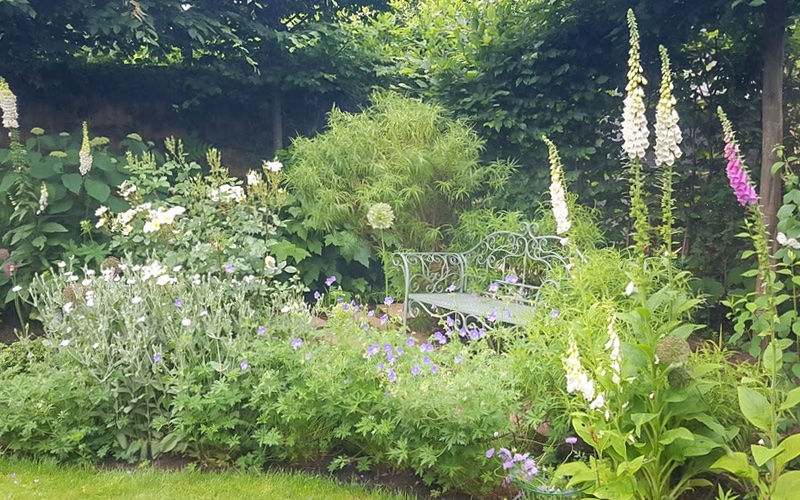
An example of a biodiverse garden by Landscaping Solutions.
Hypericum perforatum, or ‘St John’s Wort’, is a common wildflower used traditionally as a wound herb and more recently as a treatment for depression or a general tonic for lifting the spirits. The plant is named after John the Baptist who is said to have been born six months before Jesus of Nazareth on 24 June and is venerated in the Christian faith as the one who prepared the way for Christ the Redeemer to carry out his work.
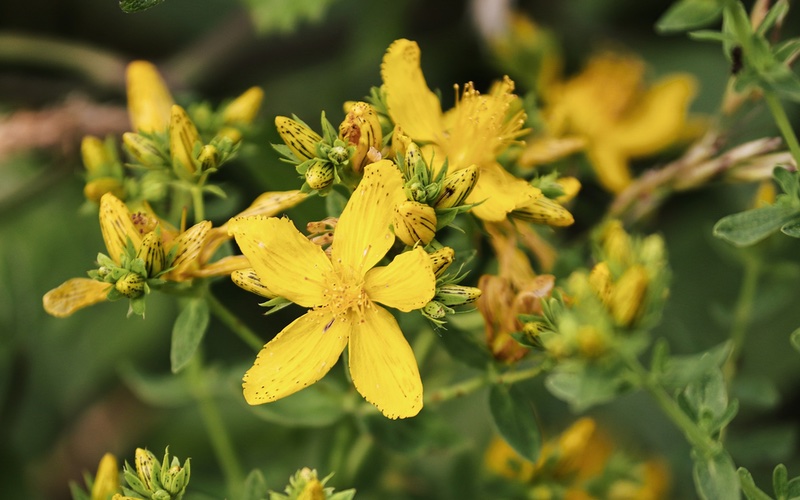
The common wildflower Hypericum perforatum, or ‘St John’s Wort’.
How fitting, then, that on St John’s Day I had the most uplifting and redeeming experience of an otherwise tumultuous year when I tuned in to an online lecture by Fergus Garrett on the subject of biodiversity at Great Dixter House in Sussex. I came away healed, hopeful and with a sense that his vision could prepare the ground for our work as ‘regenerative gardeners’.
Between 2017 and 2019, Fergus commissioned a biodiversity audit of the Dixter estate in order to confirm his hunch that the gardens represented a special place for wildlife and inform his team of how best to manage the land going forward. The audit uncovered a range of interesting findings, the most important, in my opinion, being the discovery that the abundance and variety of life in and around the house and gardens outweighed that of the estate’s hedgerows, meadows, woods and farmland.
The gardens harbour a number of nationally rare and scarce bees, wasps, hoverflies, moths and spiders. One of the ecologists proclaimed the gardens to be one of the most biologically rich sites he had studied in 30 years of surveying. So, what are they doing right at Dixter?
In my last article for the Landscaping Solutions blog, I wrote of the University of Sheffield’s ‘BUGS’ project which studied factors influencing biodiversity in gardens. The BUGS team discovered a number of recurring garden features which increased the quantity and variety of species. All these features are present at Dixter. There is an emphasis on refraining from chemical use and over-zealous mowing. Composting is championed, along with the creation of brash piles and provision of standing dead wood.
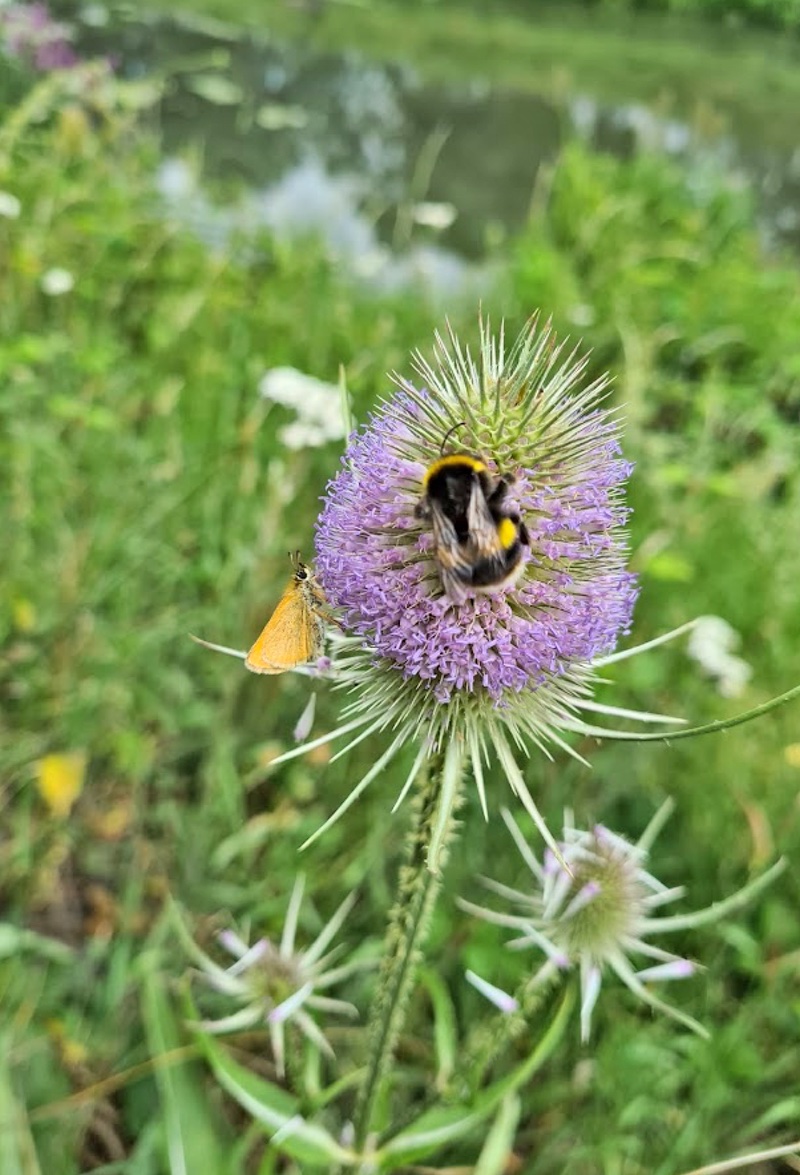
Ponds, water courses and a little untidiness not only add an aesthetic charm but also provide a practical habitat for wildlife.
The garden is famous for its successional planting providing early spring flowering fruit trees, a long-lasting summer mix of natives and exotics and diverse late season pollen and nectar sources. Hard structures have lots of nooks and crannies in which insects, birds and mammals can find shelter and raise young. Ponds and water courses are present and, crucially, there is recognition that ‘untidiness’ adds aesthetic charm as well as practical habitat.
The garden at Dixter is a dynamic and intensely managed landscape in a constant state of change. Man-made change. There is a pervading sense that, for wildlife to thrive, human intervention should be kept to a minimum. The hand of man is generally thought to be a destructive one. However, Dixter highlights humanity’s beneficial influence on the health of the planet and how thoughtful horticulture has a key role in improving biodiversity.
It’s easy to dismiss mankind as a plague on the face of the planet, but examples like Dixter remind us of the positive nature of our position in the web of life and how important gardens and gardeners are to how the picture might pan out. Which impressions will we choose to leave on the canvas of the twenty-first century? The current background is a Turneresque tempest. Will we overlay this with a depiction of the gates of hell or the Garden of Eden? The choice is ours.
Thanks and gratitude to Helen Gazeley for directing me toward the Dixter lecture. Watch it yourself here: www.vimeo.com/ondemand/biodiversitygreatdixter
THE SUSTAINABLE AESTHETIC
In late 2019 we collaborated with Jilayne Rickards on a small urban garden she designed for a great client in North London. Jilayne christened the scheme ‘The Urban Retreat’.
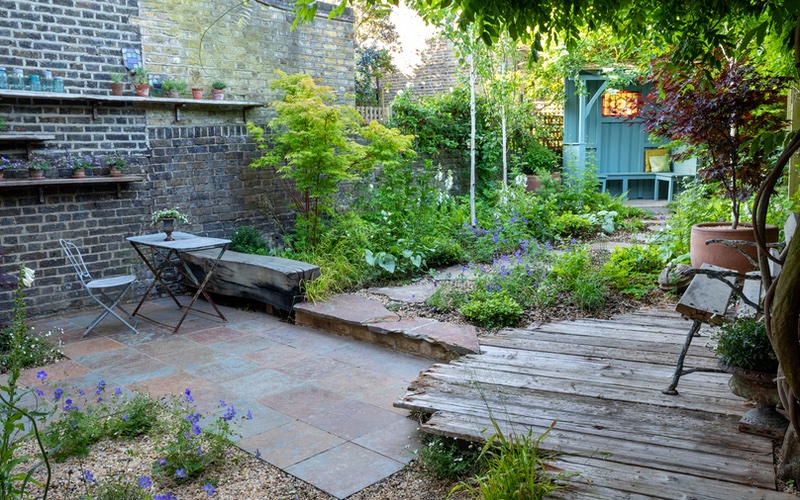
The Urban Retreat in North London, designed by Jilayne Rickards and built by Landscaping Solutions.
Jilayne’s vision was for the garden to be both beautiful and sustainable. In December last year we discovered the garden had picked up four British Association of Landscape Industries awards. The most satisfying of these for us was the award for best use of recycled and reclaimed materials. The recognition this garden received from BALI and the interest and acclaim it has garnered from the wider public offers hope for what we call ‘The sustainable aesthetic’. The more media coverage gardens of this type obtain the more they will come to be considered desirable by the general public and the more likely their guiding ethos will become mainstream thought.
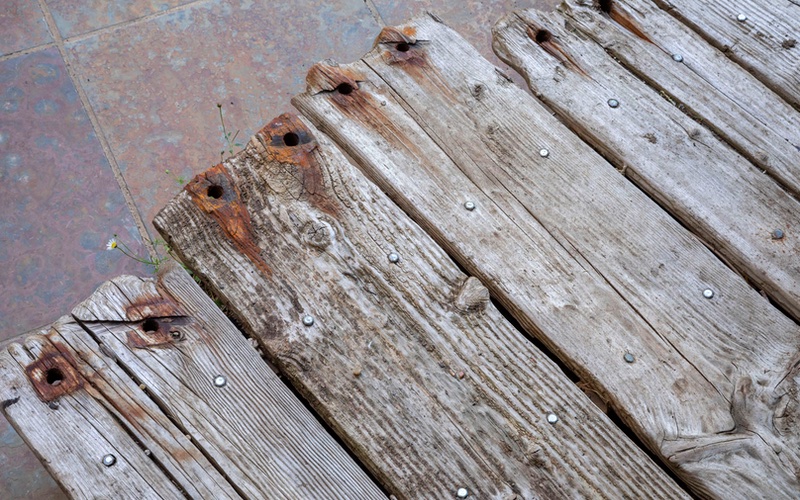
Reclaimed Douglas Fir decking, one of the many recycled and reclaimed materials used throughout the garden.
What is the ethos of the sustainable aesthetic and why is it important? The sustainable garden weathers well in the British climate, blends in with its surroundings, accommodates and encourages interaction with wildlife and does not damage the environment in its creation. It follows a number of principles;
Protect and nurture the holy trinity of soil, plants and insects. Do this and good things will follow. In ‘The Urban Retreat’ all soil was kept on site.
Reduce waste. In this garden all existing pots and planters were recycled along with the brick work. Paving sub-base materials were re-used where appropriate or sent for off-site recycling with any green waste produced. Energetic waste can also be reduced by designing closed systems and features that have multiple benefits. For example, planting Comfrey for its aesthetic appeal, ability to attract and feed insects, provision of composting material and medicinal applications.
We can further reduce waste by working with the existing lay of the land, soil type, microclimate, ‘hard’ and ‘soft’ vernacular, moisture levels, ‘habitat’ type, etc. The existing garden had a woodland edge feel and Jilayne used this to inform her plant choices. Woodland edge gardens are cooling and relaxing in the heat of a city summer.
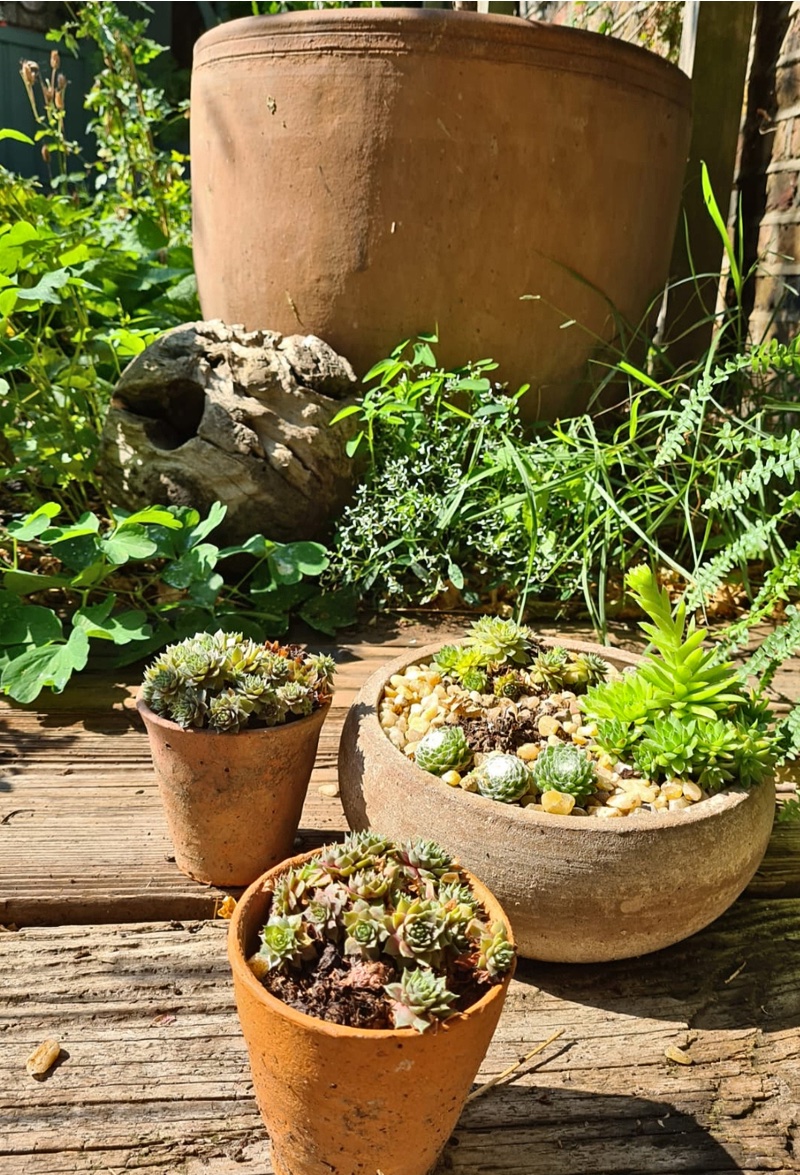
Existing pots and planters were recycled and wildlife friendly planting was retained.
Useful, wildlife friendly planting was retained and any unwanted plants were donated to other gardeners. A mature Elder was a prominent existing feature. What plant can better connect us to the environment and other lifeforms? In winter it looks a wreck and we wonder will it manage to limp on through to spring? But what a change once the sap starts to rise. The leaves come on early, connecting us to the cycle of re-birth out of decay. The summer flowers are an insect magnet and can be made in to refreshing drinks. The autumn berries feed birds and small mammals whilst boosting our immune systems through winter when processed in to medicinal food and drink. Dried out Elder canes are also the best material for the hand drill-one of the first ways our ancestors kindled fire. Try it yourself to fully appreciate their achievements! Plants of this kind re-connect us with our history and birthright and, in doing so, help dispel the illusion that we are somehow ‘outside’ of nature. Through constant exposure to the damaging aspects of our existence we have grown to believe degradation is our hallmark. Gardens are the one of the arenas in which we can reassert the positive elements of human intervention and perhaps see our purpose on this planet.
Specify plants and hardscape that don’t need mollycoddling. Opt for resilient plants and stone and timber types that don’t need constant sealing or cleaning. Reclaimed materials achieve this end and also tick the sustainability box- they have not been newly created and therefore no further finite resources have been consumed. In terms of timber, we used reclaimed Douglas Fir decking and shelving and reclaimed Oak for the seating block/retaining wall in this garden. Reclaimed slate and granite was used for the paving. Jilayne and the client went shopping in local markets for the second hand furniture, fixtures and fittings. All the reclaimed materials were of British provenance. When reclaimed wood cannot be used specify locally sourced FSC-certified timber from trusted suppliers.

Reclaimed timber, slate and granite were used throughout the garden as well as second hand furniture, fixtures and fittings.
Permeable surfaces allow rain water to percolate back in to the ground and to that end gravel was used extensively in this garden. More generally, look to make surfaces more porous with the aim of increasing biodiversity. Block and brick retaining walls could be replaced with gabions which allow unwanted existing materials such as paving and walling to be used as in-fill.
Sustainable gardens aim to be as ‘soft’ as possible. Planting should be diverse, successional and nectar-rich. Utilise a range of trees, shrubs, climbers, grasses and bulbs to provide food and shelter for wildlife. Don’t forget; attractiveness to humans is of equal importance if the garden is to be considered a success by the client!
Go easy on garden lighting and chemical weed and pest control. Neither were used in this scheme.
However, the garden wasn’t a perfect example of sustainability. There were a number of areas where our activities were damaging;
- Cement and adhesives were used. Both material have a high environmental impact.
- Fossil fuels were consumed and pollutants produced in travelling to and from site.
- Space restrictions dictated all deliveries were bagged. To reduce waste specify loose deliveries wherever possible.
- Gravel extraction degrades wildlife habitat.
How can we improve? At Landscaping Solutions we are committed to continual professional development through seminars, courses, workshops and personal study. Integration of environmental assessments to our CDM process helps us think about how we can reduce our impact and guides our landscape design decisions and installation techniques. This is a great tool but can only take us so far due to the fact that much of the raw information is based on intuition. There is a need to develop an industry accepted framework to help us better understand the relative impact of various materials and practices. For instance, we might assume artificial turf to be more impactful than paving but in some instances artificial turf allows the ground to ‘breath’ more than paving. Leave artificial turf to its own devices and it develops into ‘habitat’ much quicker than paving, rapidly hosting an array of plant and invertebrate life. However, can it be recycled satisfactorily? And which of these is most environmentally impactful; quarried British Yorkstone or Italian porcelain? What about quarried Indian sandstone v Italian porcelain? Or Indian sandstone v Indian porcelain. Yorkstone v Portland Stone? Portland stone from open cast extraction v undersea deposits? These are complicated questions.
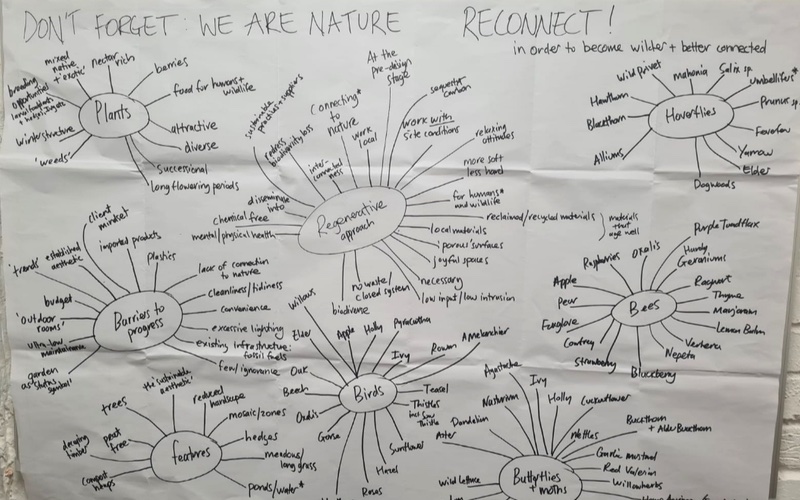
Regular brainstorming sessions helped guide our design decisions and installation techniques.
Good reliable information will enable us to compile a database of suppliers employing sustainable practices. For ‘The Urban Retreat’ we used Ashwells Timber and CED Stone.
Responsive clients might be encouraged to engage with food production be it wild or cultivated and on whatever scale possible. This takes the pressure off the industrial agricultural system, promotes personal resilience, self-sufficiency, understanding of our role in the ecosystem, empathy with other life forms and mental and physical health. Studies have shown low-input vegetable and fruit allotments to be the most biodiverse land use in the country. They can be further improved by providing a body of water and adding on-site composting facilities.
One last piece of advice; don’t forget to have fun!
RISE OF THE ECO GARDENER

An unfortunate side affect of living a modern lifestyle is losing touch with nature. As we further develop our towns and cities, slowly swallowing up fields, parks and woodland the gradual loss of our natural surroundings is becoming ever more apparent.
Thankfully, as a nation we are becoming more environmentally aware everyday and attitudes are beginning to shift. As the effects of climate change begin to touch our everyday lives, there has been a rise of eco-conscious gardeners wanting to get back to nature and live a more sustainable lifestyle.
With this change in attitudes, people are developing a greater awareness of the environment as well as becoming more considerate of garden wildlife. Recent figures released by Wyevale Garden Centres showed that 67% of people surveyed considered themselves to be eco-conscious when it came to their approach to gardening. City dwellers in particular are setting a good example when it comes to cutting back on waste and encouraging wildlife.
The same survey also revealed that more than three quarters of gardeners try to avoid using chemicals in their gardens, with 46% opting for organic fertilisers as an alternative.
The negative impact our current food system has on the environment is also becoming clear to the eco-conscious gardeners of today. For this reason, growing your own food and in particular, watching what you eat, is becoming increasingly important to many.
People want to know where their food is grown and are aware that by adopting an organic approach to growing they can dramatically reduce their food’s carbon footprint.
As a result, the grow your own movement has been gaining traction and has quickly become a key focus for the eco-conscious gardener. In fact, a recent report from The Soil Association revealed the UK organic market alone is now worth £2.2 billion.
For those starting out in eco-gardening, knowing were to start can sometimes be a daunting prospect. The trick is to start small with something simple; using recycled pots, encouraging birds and wildlife in to your garden or installing a water-butt can quickly set you on the path to becoming an eco-gardener.
If growing your own food tickles your fancy then starting with items that are relatively easy to grow is also a good way of beginning your eco-gardening journey. A perfect starting point for example would be growing tomatoes. Tomatoes require minimal effort but can still yield satisfying and tasty results.
While all this may seem like relatively small steps at first, if all of us began thinking about changes we could make in our own gardens and implementing those changes we could make a difference. Not only to our own surroundings but to the environment too.
GARDENING GETS A YOUTH TAKEOVER

Traditionally, most people see gardening as dominated by the older generation. The digital age however, has seen a new younger generation of gardeners emerge. These gardeners are learning from an entirely untraditional source; the internet and social media.
Social media and the internet are key players when it comes to kick starting trends, with sites like Instagram, Pintrest, Twitter and YouTube offering us inspiration at our finger tips. As a result, a huge network of young horticulturists are using these social media platforms to share the latest gardening tips and tricks or simply to find inspiration.
According to a survey commissioned by the Royal Horticultural Society, 89 per cent of 16 to 24 year olds said they had either a garden or an allotment and grew their own plants and vegetables.
Growing your own food and watching what you eat is a popular trend at the moment, most notably amongst young professionals. Organic food is on the rise and people are more aware than ever that growing your own fruit and vegetables can dramatically reduce our food’s carbon footprint.
In short, attitudes are changing rapidly with many under 35’s now heavily engaged in a range of gardening activities. The last few years have also seen a sharp increase in the number of 16 to 18 year olds wanting to enroll on horticultural courses at college.
The stereotype that gardening can only be enjoyed by the older generation is quickly disappearing and one such person helping to dispel that stereotype is 19 year old YouTuber Huw Richards.
Huw’s YouTube channel HuwsNursery currently has over 20 million views with upwards of 80 thousand subscribers, making it the most successful gardening vlog in the UK.
As a result of his YouTube successes Huw has also appeared on numerous TV gardening programmes and secured a number of sponsorship deals with prominent landscape and gardening related companies.
Another young British YouTuber, 22 year old Jack Shilley features similar content on his Youtube channel. One of his most successful videos entitled “planting raspberries in containers” has racked up more than 95,000 views.
When you look at statistics like this it’s clear the younger generation are getting into gardening in a big way and thankfully there are a growing number of initiatives designed to encourage and nurture this surge of interest.
BALI are a prime example of this, their hugely successful GoLandscape initiative (of which Landscaping Solutions company director Ben West is an ambassador) aims to bring more young people in to the landscaping industry by promoting and developing real life careers.
In addition The Royal Horticultural Society also run several groups and award schemes all aimed at the younger generation.
Increasingly a number of schools and colleges across the UK are also creating gardening spaces and clubs within their grounds, in an effort to embrace the enthusiasm of this new generation of gardeners.